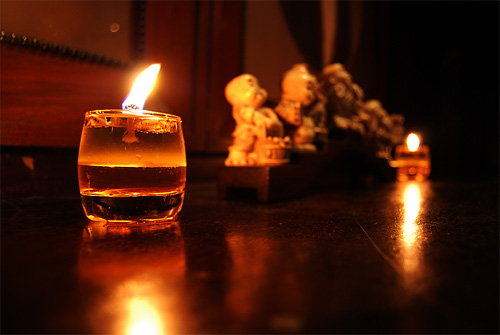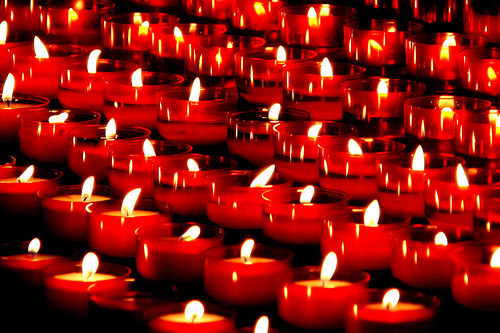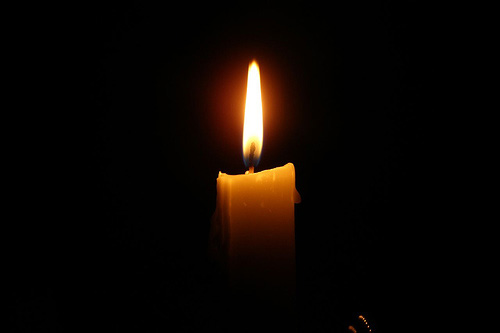Candles are a unique light source. Using candlelight to light a scene can result in breathtaking photos. Candlelight temperature is different than flash, daylight or regular bulb light. Using candlelight is hard and requires experience. This article will provide you some basic ideas to start experimenting with.
- They can be a light source that lights an object in the photo but not appear in the photo themselves.
- They can be used as a light source and also participate as an object in the final photo
- They can participate as the solo object in the photo (or in other words simply a candles photo).
Remember to eliminate other light sources: The goal of candlelight photos is to achieve an effect that is based on the unique characteristics that candlelight provides such as its warmth. In order to maximize this effect you should make sure that there are no other light sources that contaminate the scene. A simple test for that is to blow off all the candles and make sure that the scene is completely dark. It goes without saying that you should make sure that your digital camera’s flash is set to the off position. In some cases a small amount of additional light source can be used. After experimenting and gaining experience with candlelight photography you will get a sense of when allowing some other light to penetrate the scene makes sense and in which angles and intensities.
Candlelight is not as strong as other light sources. It is much weaker than your digital camera’s flash. For that reason candlelight photography will almost always result in low light slow shutter speed photography. Although it is recommended that you use a setup in which you maximize the aperture width and minimize the shutter speed it is likely that you will end up having to use slow shutter speeds.
- Camera shakings – these can be eliminated by using a tripod or by placing the camera on a stable surface and using timer photography.
- Objects movements – if objects move during the period in which the shutter is open the photo will appear smudged. Make sure that the objects you are photographing do not move and that people do not blink. Another movement source is the movement of the light source itself.
- Candles tend to flicker – although it is hard to completely eliminate this phenomenon and some flicker is actually welcome in order to get a good candlelight effect – it is recommended that you prevent extreme flicker. This can be done for example by making sure that there is no wind blowing in the scene, that the candles are on stable surfaces and that they were lit for a while and burn consistently.
Determining the right shutter speed is also hard. Since the candles light is bright on one and but on the other hand is concentrated in a small area and weak once farther from the candle most cameras ambient light measurements and automatic shutter speed settings will be wrong. Using the camera automatic setting is a good start. Try to take a few photos with slower and faster shutter speeds and explore the results.
The amount of light in the scene depends on the number of candles that are used. Since candles are not a strong light source you would usually need to use a few candles. Sometimes you would only like to have a small number of candles appear in the photo itself but you would still need to have more candlelight in the scene. In such cases you can use extra candles to light up the scene but keep those candles out of the composed photo. When you do that – make sure that the additional candles are placed in a way that make sense – for example – that they do not create shades that do not appear not normal in relation to the candles in the photo.
Lighting is an art. Using candlelight as a light source is an art by itself and requires experience. There are some basic rules for candle positioning. For example it is clear that the candles should be closer to the camera than the objects. Otherwise the result will be a silhouette of the objects. Different lighting angles create different shades and different effects. For example if you are photographing a person and the candles are placed in a low position relative to the person’s face – you will get a more scary effect. On the other hand – if the candles are placed at the same height as the person’s face you will get a warmer and softer effect. It is hard to provide candle positioning rules and such positioning greatly depends on the effect that you are looking for. More than one candle can be used with each at a different position to create more complicated effects and to eliminate unwanted shades. The best advice is to take many photos and experiment with different candle positions and angles.
Last but not least is white balancing. Digital cameras can be set to compensate for the specific light source that is used. Although most cameras can automatically detect and set their white balancing offset – it is better to manually set the white balance – most cameras include a candlelight source as an white balance option. It is also worth experimenting with setting the white balance to the wrong source on purpose. Set the white balance to different temperatures to achieve different effects, more reddish photos for example.
To conclude, candlelight photography is hard – it requires a lot of experience and understanding of lighting, shutter speeds and other photography issues. On the other hand such experience pays off with breathtaking photos and effects that sometimes appear more like artist paintings than photographs.



No comments:
Post a Comment